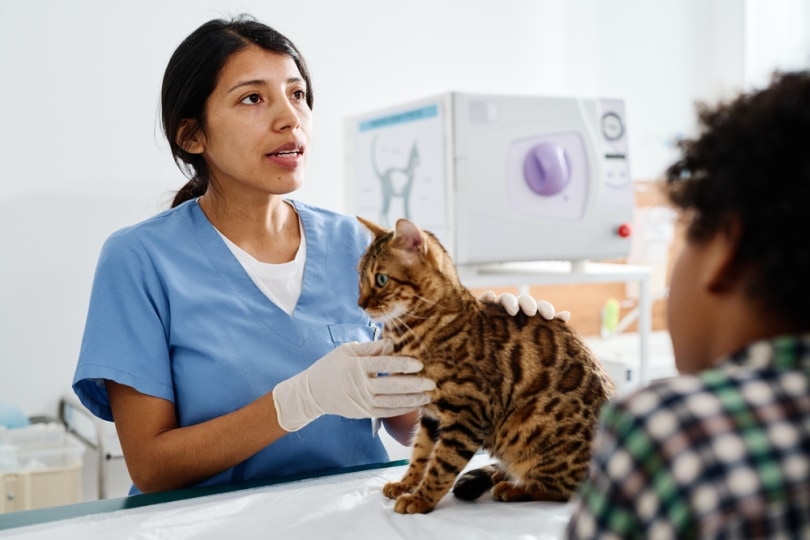
If you’ve ever been around a cat who seems particularly anxious or fearful, you may have wondered if they could have post-traumatic stress disorder (PTSD). Cats can experience traumatic events just like humans can, and signs of trauma can manifest in cats too.
Traumatized cats can display a wide range of symptoms, from anxiety to aggression, and it’s important for cat owners to understand these symptoms in order to better help their cats. In this article, we’ll discuss the causes, signs, and treatments of PTSD in cats. We’ll also look at ways to help your cat cope with their PTSD and manage its symptoms. Let’s discuss.
Can Cats Have PTSD?
PTSD affects millions of people worldwide, but can it also affect cats? The answer is yes, cats can experience trauma and anxiety that can lead to PTSD. While it is not as common as it is in people, it is certainly possible for cats to suffer from PTSD.

Causes of Trauma in Cats
Trauma in cats can be caused by a wide range of factors. Physical abuse is one of the most common causes of trauma in cats, as cats can be easily injured or even killed if abused. Emotional abuse is also a major cause of trauma in cats, as cats can become severely stressed if subjected to psychological abuse.
Cats can also experience trauma due to abandonment or neglect. Cats that are left alone for long periods of time or not given proper food, water, or medical care can become traumatized.
Illness is another major cause of trauma in cats. Cats can become traumatized if they experience a prolonged or painful illness, are physically attacked by a person or animal (even another cat), or if they have to undergo a surgical procedure. In addition, cats can also experience trauma due to a traumatic event, such as being involved in a car accident or being exposed to loud noises (such as 4th of July fireworks).
Trauma Screening Questionnaire for Cats
Before attempting to diagnose a traumatized cat, it’s imperative to first assess the cat’s overall health. A veterinary professional can conduct a physical examination and take blood tests to ensure that the cat is in good health before attempting to diagnose any psychological issues.
Once a cat’s overall health has been assessed, a trauma screening questionnaire can be used to determine if the cat is exhibiting signs of trauma. This questionnaire consists of questions about the cat’s behavior, physical symptoms, and emotional state.
By asking these questions, a veterinary professional can determine whether the cat is exhibiting signs of trauma. If the cat is displaying any of these symptoms, further investigation is necessary to determine the cause of the trauma and the best course of action.

Signs and Symptoms of Traumatized Cats
Once it has been determined that a cat is exhibiting signs of trauma, it is important to determine what signs of trauma the cat is displaying. Cats can display a wide range of indicators when traumatized, from physical signs to behavioral changes.
Physical signs of trauma in cats can include trembling, loss of appetite, weight loss, hair loss, or an increase in vocalization. Cats can also display behavioral changes when traumatized, such as aggression, fear, or avoidance. Cats may also display emotional symptoms, such as fear, anxiety, or depression.
It’s also important to note that cats can display a range of other signs when traumatized, such as excessive grooming, hiding, or meowing. These signs can vary depending on the severity and type of trauma the cat has experienced.
Treatment Options for Traumatized Cats
Once a cat has been diagnosed with trauma, it is important to determine the best course of action. Treatment options for traumatized cats can include various behavior modification techniques, medication, or a combination of the two.
Behavior modification techniques can be used to help a cat learn new coping skills and to help the cat relearn how to trust people and other animals. These techniques can include desensitization, counterconditioning, and environmental enrichment. Desensitization involves gradually exposing the cat to the source of its trauma in a safe and controlled environment.
Counterconditioning involves teaching the cat to associate positive experiences with the source of its trauma. Environmental enrichment involves providing the cat with activities and objects that can help the cat to cope with its trauma.
In addition to behavior modification techniques, medication can also be used to help a traumatized cat. Anti-anxiety medications and antidepressants can be prescribed to help a cat cope with its trauma. Veterinary experts recommend that medications only be used in conjunction with behavior modification techniques, and not as a replacement for these techniques.

Long-Term Effects of Trauma on Cats
Cats that have experienced trauma can suffer from long-term effects, such as anxiety, depression, or aggression. In some cases, it is possible that cats may also suffer from post-traumatic stress disorder (PTSD). PTSD is a serious mental health disorder that can cause a wide range of symptoms, including flashbacks, nightmares, avoidance behavior, and emotional numbing.
It’s important for cat owners to be aware of the long-term effects of trauma on cats, as these effects can have a major impact on the cat’s overall quality of life (just like with us humans). If your cat is displaying signs of PTSD, it is important to seek professional help to ensure that the cat receives the best possible treatment.
Supportive Care for Traumatized Cats
In addition to treatment, supportive care is also important for cats suffering from trauma – look at it like “activity therapy” for your cat. Supportive care can include providing the cat with a safe and secure environment, engaging the cat in interactive play and activities, and providing the cat with a variety of toys and objects to explore.
Try to provide your cat with regular veterinary check-ups to ensure that it’s in good health. Regular check-ups can also help to detect any physical or psychological issues that may be affecting the cat and can also help to monitor the cat’s progress when undergoing treatment.

Additional Tips for Helping a Cat Recover From PTSD
Helping your cat recover from PTSD will not be an easy feat, but it’s definitely possible. Here are some things that you will need during this process.
Routine
Interact with your cat every single day if you’re able. This will help him anticipate interactions with you. Knowing what is going to happen in the future makes cats feel more secure. Cats feel more secure when they can predict the future and are therefore more likely to act aggressively when unexpected events occur. Remember, baby steps.
Patience
It takes a lot of patience to socialize timid, scared, or traumatized cats. No matter their age, each cat will learn and grow at their own pace. Though older cats tend to socialize more quickly it can still take weeks or months to get them out of their shell. So, to say, just follow your cat’s lead and don’t expect too much.
Consistency & Frequency
In the first few weeks, it’s best to have frequent interactions with your cat – even if you want to keep the cat in the same room as you work, it may do it a lot of good. If the cat is able to hear and see humans, it may help it feel safer.
Conclusion
Trauma in cats can range from mild to severe and can affect cats of all ages. Trauma in cats can be caused by a variety of factors, including abuse, abandonment, neglect, or illness. Cats may experience PTSD just like humans. Signs and symptoms of PTSD in cats can include weight or hair loss, trembling, loss of appetite, fear, and seemingly random aggression.
If you believe that your cat is suffering from PTSD, it’s best to take it to a veterinary expert for a professional diagnosis. In most cases, the vet will recommend my behavior modification techniques and medication, in addition to supportive care to help a cat recover.
Featured Image Credit: Konstantin Aksenov, Shutterstock








